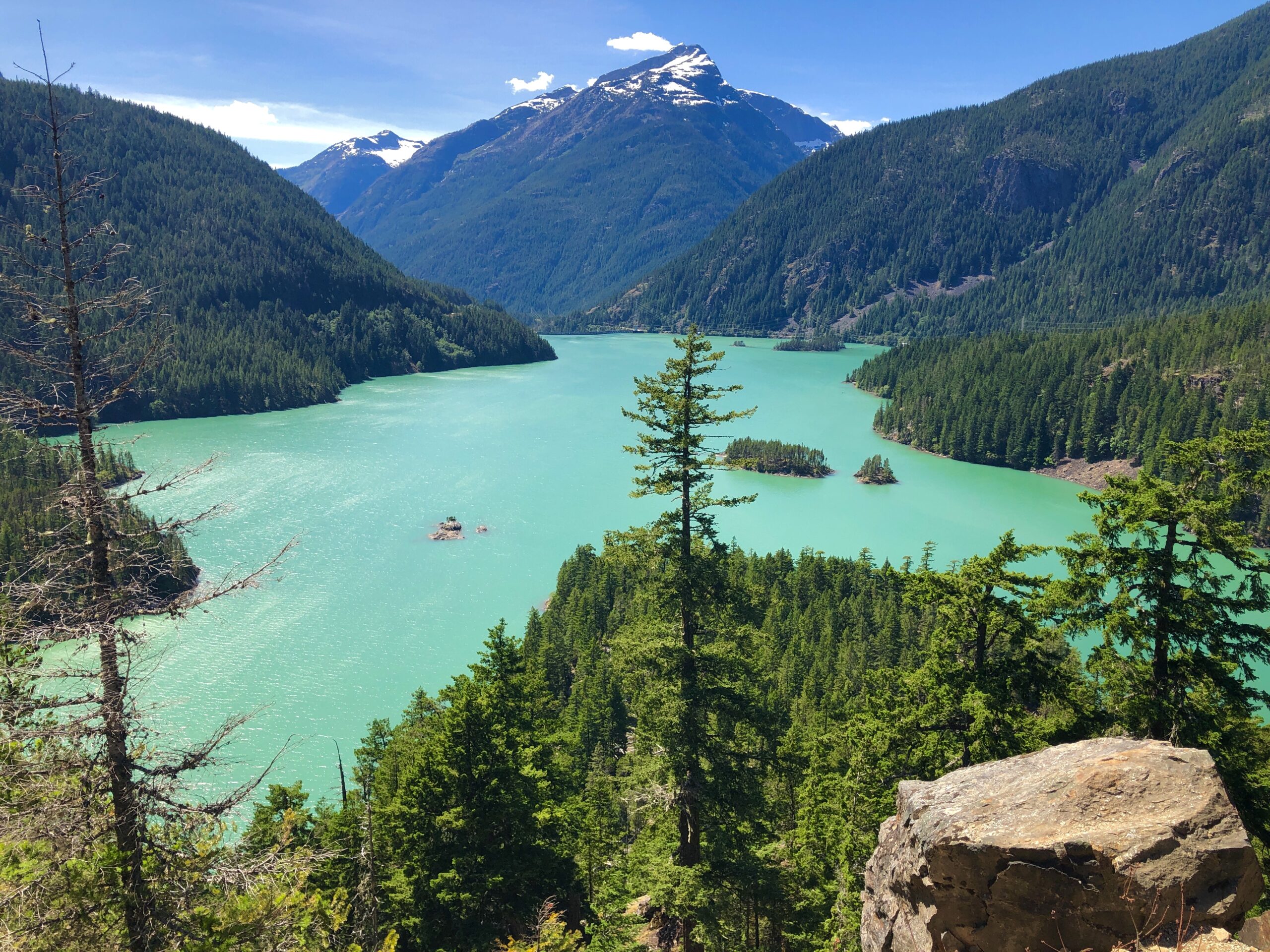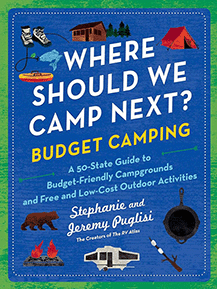Stories about America’s overcrowded National Parks pop up in the media again and again–and sometimes it does seem like everyone in the country (and from abroad) wants to visit the same five or six national parks during the same two month time period every summer.
But seasoned travelers know that our National Park Service has so much more to offer than just iconic parks like Yellowstone, Yosemite, Zion, Acadia and Great Smoky Mountains National Park. There are so many great alternatives to our busiest parks and many of them are amazing and very underrated. But where are the five most underrated national parks in the country? And where should you stay if you visit them?
We invited our friend Shellie Bailey Shah onto The RV Atlas podcast to find out more about the five most underrated National Parks in the country. To listen to her talk to us about the these amazing parks, click on the media player above or subscribe to The RV Atlas wherever you get your shows. Or just read on right here. Shellie is also our guest blogger on this very topic.
Article by Shellie Bailey-Shah
Great Sand Dunes National Park in Colorado

photo by Shellie Bailey-Shah
This park ranks as one of our favorites on this list of underrated national parks because it was just really fun for the kids. The park boasts several diverse ecosystems: grasslands, wetlands, aspen forests, and tundra, but it’s the 30-square-mile dunefield that’s the big draw here. You’ll want to start your day early here because by the afternoon, the sand temperature can reach 150°F, depending on the time of year. I’d recommend a hike to High Dune at sunrise or certainly no later than 7:30 a.m. Afterwards, it’s time for some fun. You can choose from sandboarding and sand sledding! There’s a store just outside the park that rents boards and sleds that are specially-designed for sand. Trust me, snow sleds, snowboards, round saucers, and cardboard will not work.
After an hour or so of climbing up and down the smaller dunes, you’ll be wiped out. It’s then time to head to Medano Creek at the base of the dunefield to spend the remainder of your day. This creek is a great water playground that has this phenomenon called “surge flow” — where rippling waves just appear from nowhere. Medano Creek is one of the only places in the world where that occurs. We also love Great Sand Dunes because it’s one of the few national parks that allows dogs, even on the dunefields, though you need to be mindful of the hot sand on your dog’s paws.
- To find our more about Great Sand Dunes National Park in Colorado check out this article over at KidTripster.com.
North Cascades National Park in Washington

photo by Shellie Bailey-Shah
I live in Oregon, so driving to North Cascades National Park is not that difficult. It’s located in northern Washington State along the Canadian border. I think of this park as a much less busy version of Glacier National Park. The topography here is similar to Glacier — fantastic mountain views, aquamarine alpine lakes, meadows of wildflowers and similar wildlife; we did see a bear off-trail in North Cascades. It has really challenging hiking. If if you hike high enough, just like in Glacier, you’ll find snow. My youngest son has never seen a lake he didn’t jump in, even if its partially covered in ice.
There are plenty of campgrounds to chose from here including Newhalem Creek Campgrounds and Gorge Lake Campground. We really like the little town of Winthrop. It has those wild west vibes and reminded me of Medora outside of Theodore Roosevelt National Park.
North Cascades National Park easily makes my list of most underrated national parks in the country.
Death Valley National Park in California

photo by Shellie Bailey-Shah
I know that you’ve covered Death Valley in depth in a previous blog post, but I do want to cover it here as well. I think this park continues to be one of the most underrated national parks in the country. It’s surprisingly diverse and vast. We spend just two days here on our visit, and I think everyone wished that we’d had another two days to explore.
Some highlights? We enjoyed the Mosaic Canyon hike where you wind through narrow corridors of polished rock before it opens up into a wide canyon. You can also hike the Mesquite Flat Sand Dunes. This rather bizarre sand dune field is formed by three different types of dunes: crescent, linear, and star-shaped. Of course, Death Valley’s claim to fame is its elevation. At Badwater Basin, you’ll be standing at 282 feet below sea level, the lowest spot in North America. Turn around and look up on the hill behind the basin to spot the sea level marker. You’ll be amazed at just how low you really are!
You can drive the scenic 9-mile loop called Artist’s Drive. The surrounding hills look like they’re striped with chocolate. (Or maybe I was just hungry!) If you have extra time which unfortunately we didn’t, you can head out to the mysterious Racetrack. It’s a dry lakebed where rocks – some 700 pounds in weight – mysteriously slide, leaving behind long tracks.
So again, lots of variety! And of course, the key to visiting Death Valley is visiting during the right time of year. Early spring or late fall is the best.
Because of Death Valley’s size, I’d suggest that you stay where you play. In other words, plot out how you plan to move around the park and choose your campground or lodging according. We started our stay in the central part of the park near Mosaic Canyon and Mesquite Sand Dunes at Stovepipe Wells RV Park. Frankly it’s nothing more than a gravel parking lot with hookups, but it’s near those hikes. We also stayed at The Ranch at Furnace Creek, which was really packed and oddly laid out; its saving grace is the large pool. It’s best to get up really early, explore the park until around noon and then retreat to the pool.
To find out more about Death Valley National Park in California check out this article over at KidTripster.Com.
Carlsbad Caverns National Park in New Mexico

photo by Shellie Bailey-Shah
Carlsbad Caverns in New Mexico is fairly well known, but I put it on this list for two reasons: 1) in my opinion, it’s the best cave park in the system — better than Mammoth, Wind and certainly Great Basin, and 2) it’s really well run — it has a nice visitor center, fabulous gift shop and really good ranger programs.
I do think my impression of this park was influenced by a really unique opportunity that we had to go into the cave with a ranger first thing in the morning and walk around and flip all the lights on. It just made for these wow! moments. I should say the lighting is really well done in this cave, and really helps to accentuate all the features.
Lastly, you need to plan your trip so you can see all the bats exit the cave opening in the early evening. It’s quite the spectacle. There is no RV camping inside the park. We stayed at the nearest RV park, called Whites City RV Park. It was unremarkable, but that’s not why we were there.
Wrangell-St. Elias National Park in Alaska

photo by Shellie Bailey-Shah
I’ve saved my favorite for last. And while this is a drop-dead-gorgeous Alaska park, it’s really all about the experience that we had here. Wrangell-St. Elias is the country’s largest national park, 13.2 million acres. To put that in perspective, that six times the size of Yellowstone. Four major mountain ranges converge inside this park with nine of the 16 highest peak in the U.S. The word “grand” doesn’t even begin to explain it.
The park service has divided it into four areas, but we focused on the central section and the small towns of McCarthy and Kennecott. And this is where I have to admit that I wouldn’t visit this park by RV; you can’t get where I’m telling you to go by RV. It’s a 7-hour drive from Anchorage; the last 60-miles is on a teeth-chattering gravel road where you can’t go faster than 35 mph. This road ends at a footbridge where you park your car. You then board a shuttle for the last miles to Kennicott Glacier Lodge. (Note for you: Kennecott and Kennicott are the correct spellings; the article below explains why.)
This lodge has to be one of the most well-located lodges in all the national parks, overlooking 25 miles of glacier and surrounded by 14 of the highest mountain peaks on the continent. The views are absolutely stunning. The lodge consists of two buildings: the Main Lodge and the South Wing. The Main Lodge is the original structure and houses the lobby, restaurant, and 24 guest rooms. Nearly every inch of the walls are covered with fascinating memorabilia from the copper mining days. It’s important to know that the rooms are smaller than typical hotel rooms and don’t have en suite bathrooms. There are seven bathrooms and six shower rooms for shared use. For that reason, I strongly suggest staying in the more modern South Wing, which does have en suite bathrooms. The majority of guests opt for the 3-meal plan; dinner is served family-style.
On the first day, we toured the old copper mine which for the most part is still intact and has a very rich history. But on the second day, our family booked a trip with St. Elias Alpine Guides to go ice climbing, probably one of the memorable things we’ve ever done. It’s physically demanding — you walk 9 miles, 5 miles in heavy climbing boots and crampons plus you’re carrying gear. But mind you, our superhuman guide was carrying an 80-pound pack, so no complaining. So you hike from the lodge to Root Glacier and then across the moraine to your first climbing site: an impressive, 100-foot ice face. After a lesson, you grab your two ice tools and climb on!
After our second climb, our boys did something that my husband and I refused to do. They jumped into one of those sapphire blue glacial pool where the temperature was about 28-degrees. I’ve never seen them scrabble out of water so quickly! At the return trip, our boys scrambled down a sheer cliff with the guide to explore an ice cave below. They reported back that it was very cool, but at that point, my husband and I were done.
The town of McCarthy is sort of legendary in Alaska. We happened to be there on July 4, so we got to see the annual parade… so Alaskan. It runs through the town which is all of probably 6 block twice… half the town participates the first time through while the other half spectates, and then they switch for the second time. The whole thing was homespun, quirky and very patriotic.
To find out more about Wrangell-St. Elias National Park in Alaska check out this article at KidTripster.com.
Thanks so much to Shellie for sharing her list of the five most underrated national parks in the country! Make sure you listen to the corresponding RV Atlas podcast to find out even more!
Shellie Bailey-Shah is the founder of KidTripster.Com–an online family travel resource with a dedicated Outdoors section. She has written about national parks for years on that website and she has been an invaluable correspondent to the rvatlas.com and to the RV Atlas podcast. As of this July, Shellie will have visited every single national park in the country — that’s 63 for those counting! You can follow @KidTripster on Instagram, Facebook and Twitter to find more of Shellie’s work.








